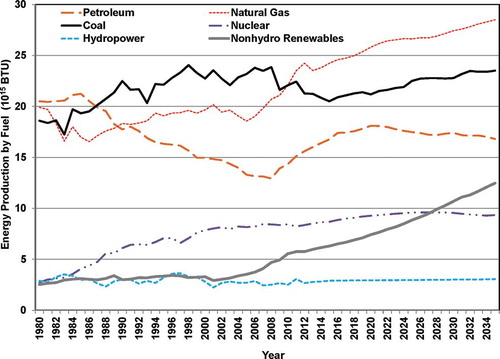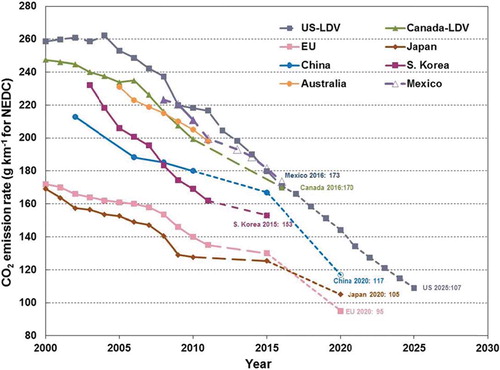Figures & data
Table 1. Conversion factorsFootnote a among different units to measure energy content and output (CitationAPS, 2012; CitationBP, 2012; CitationNRC, 2008)
Figure 1. U.S. Energy production by fuel, 1980–2035 (EIA, 2012). The major expansion of natural gas use is dependent on continued success with domestic shale sources and maintaining a low cost.

Table 2. North American fossil fuel reservesFootnote a (IER, 2011)
Table 3. Estimated cost of new electricity generation resources for CY 2017 (EIA, 2012)
Table 4. Trends in light-duty vehicle (LDV) characteristics for seven model years (EPA, 2012)
Table 5. Potential GHG emission rate reductions from available technologies applied to internal combustion light-duty vehicles (CitationLutsey, 2010)
Figure 2. Future projections for light-duty vehicle (LDV) CO2 emission rates for different countries based on historical performance and proposed or enacted fuel efficiency standards (CitationCARB, 2008; CitationEC, 2009a; CitationEC, 2009b; CitationGCC, 2009; CitationJAMA, 2010; CitationNHTSA, 2011; CitationNHTSA, 2012; CitationNTC, 2012; CitationNTCAS, 2012; CitationTransport Canada, 2009; CitationU.S. EPA, 2010). Solid symbols and lines represent historical performance, solid symbols and dashed lines represent enacted targets, solid symbols and dotted lines represent proposed targets, and hollow symbols and dotted lines represent targets under study. China's target reflects gasoline-powered vehicles only. The target may be lower after new energy vehicles are considered. U.S., Canada, and Mexico LDVs include light-commercial vehicles. NEDC, New European Drive Cycle (CitationDieselNet, 2012b).

Figure 3. Technological evolution of LDV toward greater drivetrain electrification. Moving from left to right requires: (1) increased electrical complexity: battery size and electronic controls; (2) more frequent electric motor assist and electric-only propulsion; (3) increased capacity for regenerative power during braking; (4) increased accessory electrification (e.g., air conditioning, heating, power steering, lights, and audio); and (5) increased use of grid electricity or hydrogen/fuel cell with low life cycle GHG emissions.
